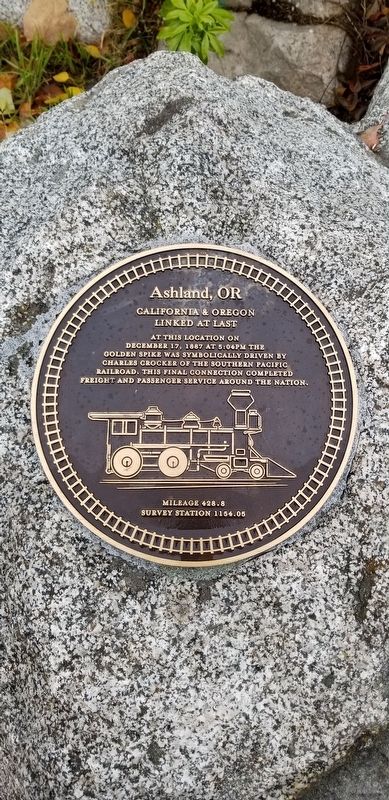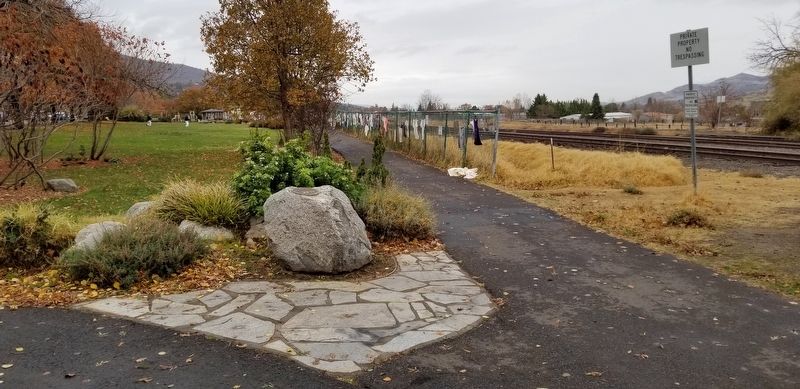Ashland in Jackson County, Oregon — The American West (Northwest)
Ashland, OR
California & Oregon Linked At Last
Mileage 428.8
Survey Station 1154.05
Erected 2016.
Topics. This historical marker is listed in this topic list: Railroads & Streetcars. A significant historical date for this entry is December 17, 1887.
Location. 42° 11.835′ N, 122° 42.108′ W. Marker is in Ashland, Oregon, in Jackson County. Marker can be reached from 9th Street Alley. This marker is located at the east end of Railroad Park. Touch for map. Marker is in this post office area: Ashland OR 97520, United States of America. Touch for directions.
Other nearby markers. At least 8 other markers are within walking distance of this marker. The Applegate Trail (about 400 feet away, measured in a direct line); Ashland’s Golden Spike (approx. 0.2 miles away); Ashland Cemetery War Memorial (approx. 0.3 miles away); Enders Building No. 1, 1914 (approx. half a mile away); Citizens Banking and Trust Company (approx. half a mile away); Applegate Trail - Ashland Creek (approx. 0.6 miles away); McCall Magnolia (approx. 0.6 miles away); The Whittle Garage (approx. 0.6 miles away). Touch for a list and map of all markers in Ashland.
More about this marker. This marker was ceremoniously erected and dedicated on July 28, 2016.
Regarding Ashland, OR. The Mail Tribune (December 16, 2012 edition) wrote a great little article highlighting this historic event in 1887 and it reads:
It was rapidly growing dark, with a chilling wind and damp fog, yet the large crowd waited patiently along the Ashland railroad tracks.
The train from California was late, slowed at every station by small crowds warming themselves against December's freeze around bonfires, and each demanded a few brief words of oratory from the train's distinguished passengers.
The day had broken clear and cold. Shallow snow dusted the Cottonwood Valley as three linked-together, six-wheel locomotives left Hornbrook Station and began the twisting and arduous pull up the Siskiyou Mountains. Six Pullman coaches followed behind.
Three cars were filled with more than 80 excursionists who were not part of the official party but had come along for the ride into history. A pool of reporters shared Southern Pacific Railroad Superintendent Jerome Fillmore's car and one car of their own. But the most important of all was Charles Crocker's luxurious private Pullman. Crocker, vice president of Southern Pacific, was coming to Oregon to connect the final link in a railroad that not only joined the entire Pacific
Coast, but, as Crocker said, would also be the longest line in the world controlled by one company, 3,336 miles from Portland to New Orleans.
At the Siskiyou Summit, the tracks had been cleared of snow, and as they passed out of the darkness in Tunnel 13, passengers could barely make out the snowless and "sublime" valley more than 2,000 feet below.
"The road winds downward," said a reporter, "a serpentine course, coiling back upon itself so that in places the track runs within 200 or 300 feet of the point just passed a few minutes before."
The sun had already set when the train arrived to enthusiastic cheers at the southern end of the Ashland rail yard. In the flicker of bonfires on both sides of the tracks, at least 1,000 people, including the Ashland band and the 44-member Oregon delegation, all came to life.
As soon as the train stopped, Crocker stepped onto the tracks, a silver hammer in one hand and a golden spike in the other.
"I hold in my hand the last spike," Crocker said.
"Higher! Hold it higher!" shouted some in the crowd.
"I propose now to unite the rails between California and Oregon," he said. "I hope it will be the means of cementing the friendship of the two states and make them as one people. [Applause.] I hope that the people of California and Oregon will always maintain their freedom, maintain their public schools, and maintain everything that conduces to their happiness and virtue."
At 5:08 p.m. on Dec. 17, 1887, Crocker slowly tapped the golden spike three times with the silver hammer. At San Francisco's Presidio, a cannon blast was fired at each tap. In New Orleans, El Paso, Los Angeles, San Francisco, Sacramento, Roseburg, Salem, Portland — at any city along the Southern Pacific line — guns, firecrackers, fire alarms and church bells erupted in celebration. The hammer and spike had been wired to the telegraph network so that each tap sent a signal down the line.
Less than two hours later, after some music and a series of speeches, the train continued north.
In Portland, Crocker reminded some businessmen that it once took seven days by stagecoach to get between Portland and San Francisco.
"Now," he said, "you can get into your rail car and journey for seven or eight days and be in New Orleans."
No doubt about it. The world was getting smaller.
Related marker. Click here for another marker that is related to this marker.
Credits. This page was last revised on November 24, 2020. It was originally submitted on November 24, 2020, by Douglass Halvorsen of Klamath Falls, Oregon. This page has been viewed 128 times since then and 10 times this year. Photos: 1, 2. submitted on November 24, 2020, by Douglass Halvorsen of Klamath Falls, Oregon. • Syd Whittle was the editor who published this page.

